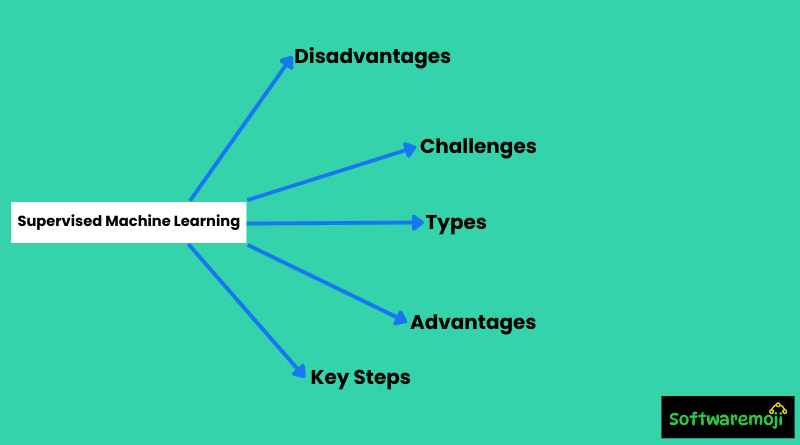
Supervised Machine Learning:
➡️What is Supervised Machine Learning?
Supervised Machine Learning is a method where algorithms learn from labeled data to make predictions or decisions. In this type of learning, the input data comes with labels or outputs, helping the algorithm “understand” the relationship between input features and corresponding outcomes. This approach mimics learning under supervision, where the system is guided with known results to predict future outcomes.
➡️Key Steps in Supervised Machine Learning:
- Data Collection: Start by gathering labeled data that includes inputs (features) and the correct outputs (labels).
- Training: The algorithm learns the patterns in the data by mapping inputs to outputs.
- Prediction: After training, the algorithm can predict the output for new, unseen data.
For example, predicting a house price based on features like size, location, and number of rooms is a typical use case of supervised learning.
➡️How Supervised Machine Learning Works:
In Supervised Learning, the model learns from the input-output pairs in the training dataset. For instance, if you’re building a model to predict commute time based on factors like weather, time of day, and traffic conditions, you would:
- Label the Data: Collect data on commute times with corresponding weather conditions, time, and other relevant features.
- Train the Model: The algorithm learns how these factors influence commute time.
- Prediction: After learning, the model can predict future commute times when new data (weather, time, etc.) is provided.
The model identifies patterns like “rainy days increase commute time” or “leaving work at 6 PM leads to longer travel time.”
➡️Types of Supervised Machine Learning Algorithms:
- Regression Algorithms:
- Linear Regression: Predicts a continuous value. For example, estimating house prices based on size and location.
- Logistic Regression: Used for binary outcomes like whether a customer will buy a product or not. It predicts probabilities, making the output fall between 0 and 1.
- Classification Algorithms:
- Decision Trees: These models split data into branches based on feature values. Ideal for problems like classifying emails as spam or not.
- Naive Bayes: A probabilistic classifier used for tasks like sentiment analysis or text classification.
- Support Vector Machine (SVM): Effective for high-dimensional spaces and tasks like image recognition or gene classification.
➡️Supervised Learning vs. Unsupervised Learning:
| Aspect | Supervised Learning | Unsupervised Learning |
|---|---|---|
| Data Type | Labeled data (input-output pairs) | Unlabeled data |
| Complexity | Simpler, easier to implement | More complex, requires advanced techniques |
| Use Cases | Predicting outcomes based on labels | Discovering patterns and relationships |
| Accuracy | Generally more accurate | Less accurate, requires more data |
➡️Challenges in Supervised Machine Learning:
- Data Quality: The presence of irrelevant or noisy data can lead to inaccurate predictions.
- Overfitting: If the model is too complex or trained on limited data, it may perform well on training data but poorly on new data.
- Computational Cost: Training models, especially with large datasets, can be time and resource-intensive.
➡️Advantages of Supervised Machine Learning:
- Accuracy: Because the model is trained on labeled data, it often yields highly accurate predictions.
- Predictive Power: Once trained, these models can make reliable predictions on new, unseen data.
- Versatility: Supervised learning can be applied to a variety of tasks, including classification and regression.
➡️Disadvantages of Supervised Learning:
- Data Dependency: The quality of predictions heavily depends on the quality of the labeled data.
- Computational Complexity: Training models with large datasets requires significant computational resources.
- Limited to Labeled Data: The method cannot be used effectively without labeled data, making it less useful in certain real-world scenarios.
➡️Best Practices for Supervised Learning:
- Data Preprocessing: Clean and prepare the data before training. Handle missing values, outliers, and normalize features if needed.
- Feature Selection: Choose the most relevant features for training to avoid overfitting and improve model efficiency.
- Cross-Validation: Use techniques like cross-validation to ensure the model performs well on unseen data.
Beginner’s Guide to Deep Learning:-
➡️Conclusion:
Supervised Machine Learning plays a crucial role in predictive analytics and decision-making. Whether it’s predicting house prices, classifying emails, or forecasting sales, this method can provide powerful insights with the right data and algorithms. However, challenges like overfitting and the need for labeled data should be addressed for optimal model performance.
By carefully selecting algorithms, preprocessing data, and employing best practices, you can successfully implement supervised learning to solve real-world problems.
